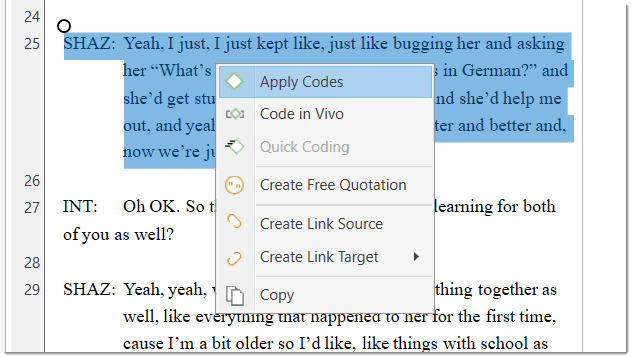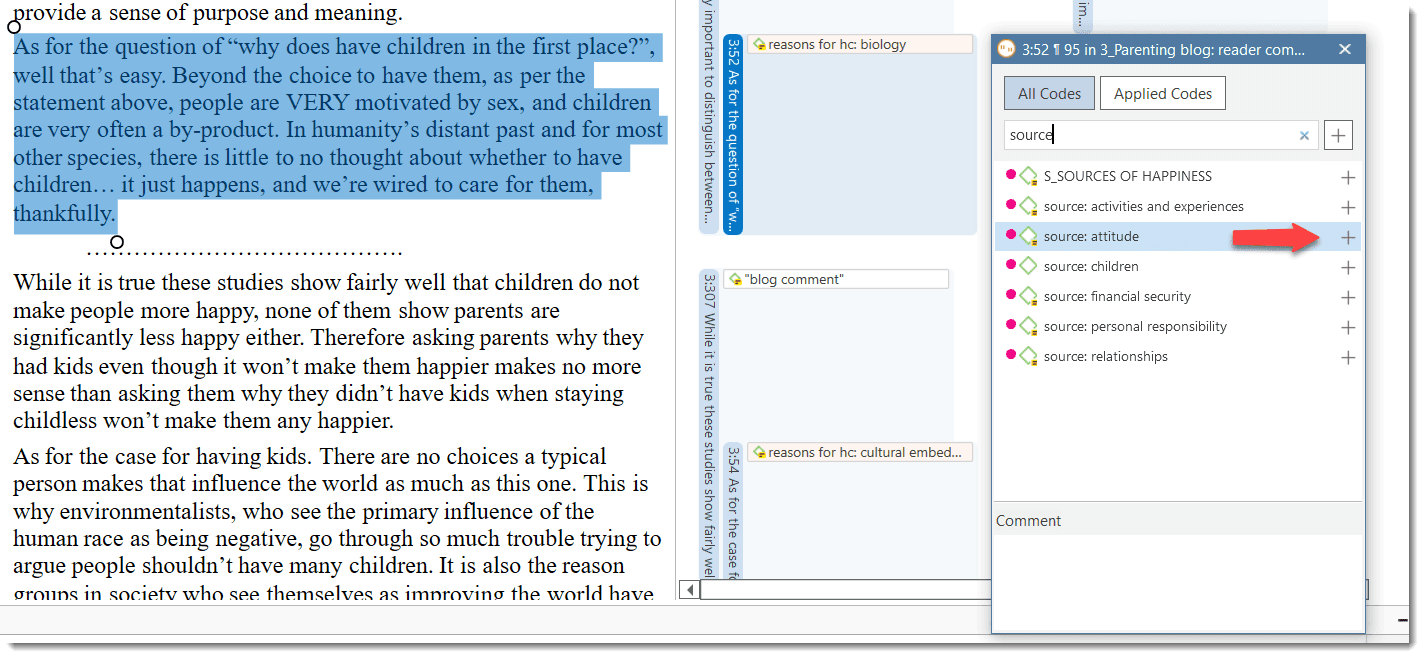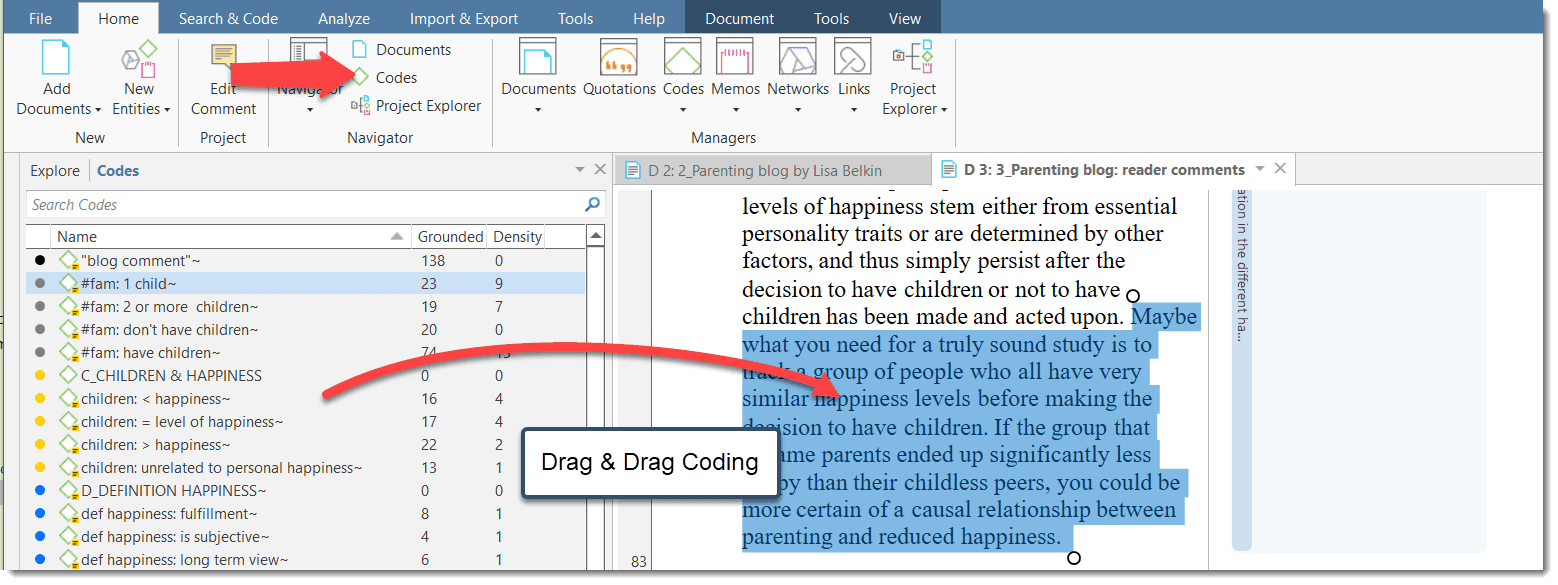Coding Data
“Coding means that we attach labels to 'segments of data' that depict what each segment is about. Through coding, we raise analytic questions about our data from […]. Coding distills data, sorts them, and gives us an analytic handle for making comparisons with other segments of data” (Charmaz, 2014:4).
“Coding is the strategy that moves data from diffuse and messy text to organized ideas about what is going on” (Richards and Morse, 2013:167).
"Coding is a core function in ATLAS.ti that lets you “tell” the software where the interesting things are in your data. ... the main goal of categorizing your data is to tag things to define or organize them. In the process of categorization, we compare data segments and look for similarities. All similar elements can be grouped under the same name. By naming something, we conceptualize and frame it at the same time" (Friese, 2019).
Creating New Codes without Coding
You can create codes that have not (yet) been used for coding. Such codes are called "free" codes. This can for example be useful when ideas for codes come to mind during normal coding work and that cannot be applied to the current segment but will be useful later. Sometimes you also need free codes for expression conceptual connections in networks. If you already have a list of codes, possibly including code descriptions and groupings elsewhere, you can use the option: Importing A List Of Codes.
In the Home tab, click on New Entities and from the drop-down menu select New Code(s). The short-cut key combination is Ctrl+K.
You can also create new codes in the Code Manager.
inst
Click on the button Free Code(s) in the ribbon of the Code Manager.
Coding with a New Code
Open a document and highlight a data segment, i.e. a piece of text, a rectangular area in a graphic document, a section on the audio wave of a video or audio document, or a location in a geo document.
inst
Right-click and select Apply Codes, or use the short-cut Ctrl+J, or click on the 'Apply Codes' button in the ribbon.

inst
Enter a name and click on the plus button or press enter.
 You can continue to add more codes, or simply continue to select another data segment. The dialogue closes automatically.
You can continue to add more codes, or simply continue to select another data segment. The dialogue closes automatically.
for more information on working with data other than text, see Working With Multimedia Data and Working With Geo Docs.
Display of Coded Data Segments in the Margin Area
The coded segment is displayed in the margin area. A blue bar marks the size of the coded segment (= quotation), and the code name appears next to it. When coding data in this way, a new quotation is created automatically, and the code is linked to this quotation.

Applying Existing Codes
Existing codes can be applied using the Coding Dialogue or via Drag & Drop.
Using the Coding Dialogue
Highlight a data segment, right-click and select Apply Codes, or simply double-click on the quotation.

inst
Select one of the existing codes, click on the plus button or press Enter. If you type the first few letters in the entry field, only those codes are presented that match the letter combination.
Code density is not a value that is calculated by the software. It goes up, when the researcher begins to link codes to each other. See Working With Networks.
Drag-and-Drop Coding

Drag-and-Drop Coding is possible from the following locations:
- the Codes branch from the Project Explorer
- the Code Browser in the navigation panel.
- the Code Manager Below you find more Drag-and-Drop options.
To use drag-and-drop coding highlight a data segment, select one or more codes in the above mentioned lists or windows and drag the code onto the highlighted data segment.
Code Browser in the navigation panel: To open the Code Browser, go to the Home ribbon and select Codes from the Navigator section. The search field in the Code Browser facilitates handling a longer code list. Rather than scrolling the list, you enter the first letters of a code. Code Manager: When using the Code Manager, it is recommend to place it next to the text you are coding into a new tab group. See Working With Docked And Floated Windows. You can quickly access codes using code groups to filter the list, or by using the search field. In the Code Manager you can see and edit code comments.
Code In-Vivo
Use in-vivo coding when the text itself contains a useful and meaningful name for a code. In-vivo coding creates a quotation from the selected text AND uses the selected text as the code name. If the selected text's boundaries are not exactly what you want for the quotation, modifying the quotation's "spread" is often the next step after creating the in-vivo code. See Working with Codes > Modifying the length of a coded segment.
Select a segment in a text document, right-click and select Code in Vivo, or the corresponding button in the ribbon.
In-Vivo coding can only be applied to textual primary documents.
Quick Coding
Quick Coding assigns the last used code to the current data segment. This is an efficient method for the consecutive coding of segments using the most recently used code.
Highlight a data segment or click on an existing quotation.
Right click and select Quick Coding from the context menu, or use the short-cut Ctrl+L. Another option is to click on the Quick Coding button in the ribbon, but this is (admittedly) less quick.
Keyboard Shortcuts F
| Coding | Short-Cut |
|---|---|
| Create Free Code | Ctrl+K |
| Apply Codes | Ctrl+J |
| Quick Coding | Ctrl+L |
| Code In-Vivo | Shift + Ctrl + V |